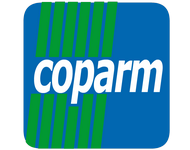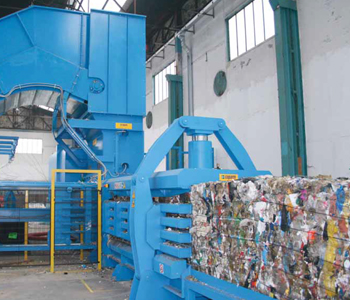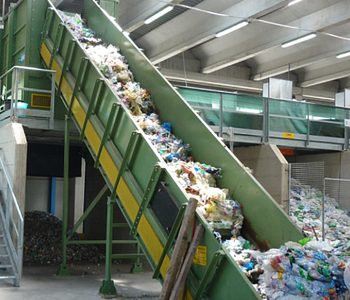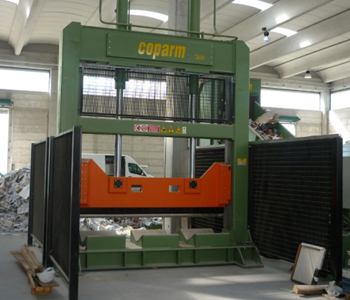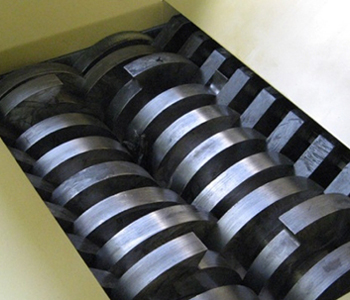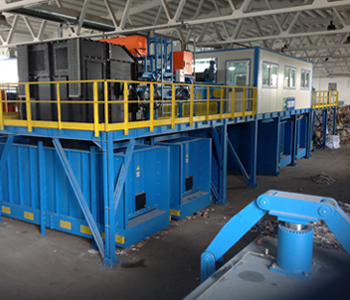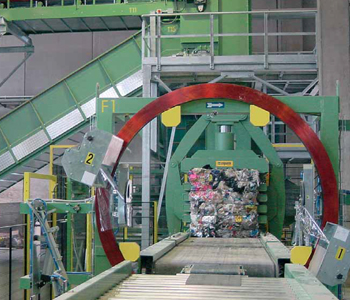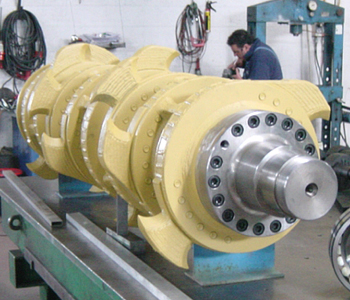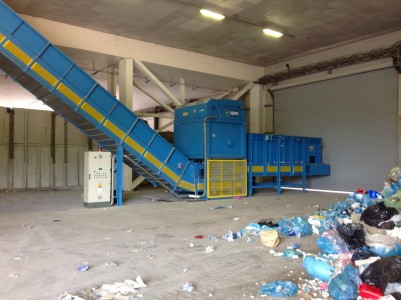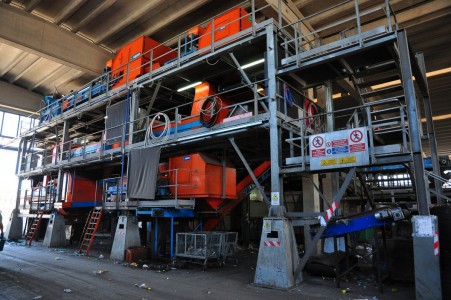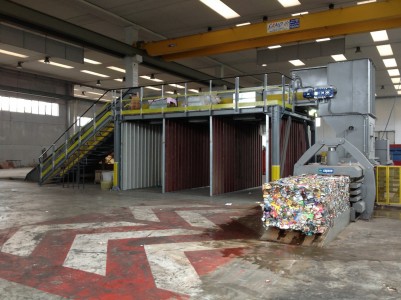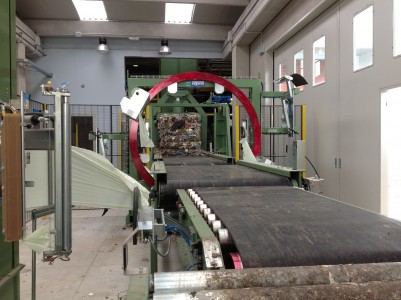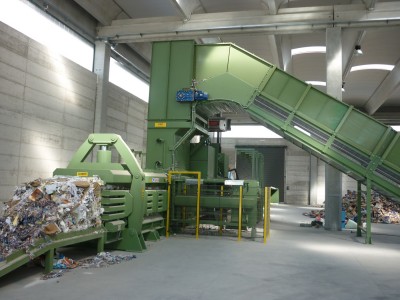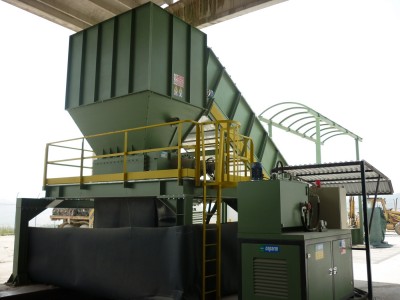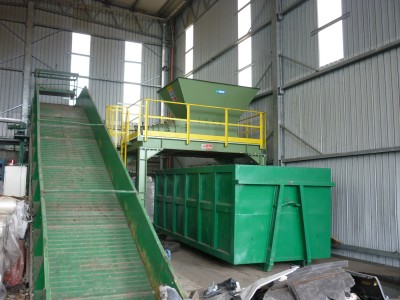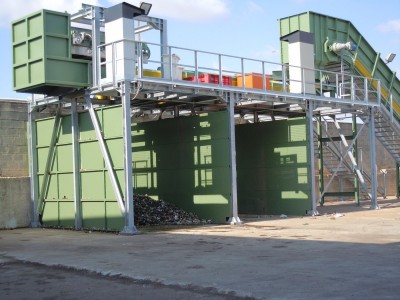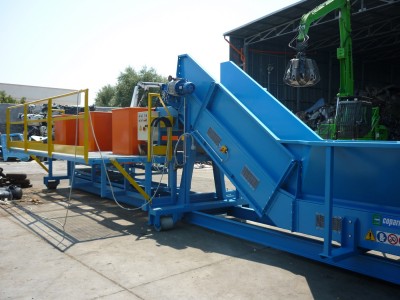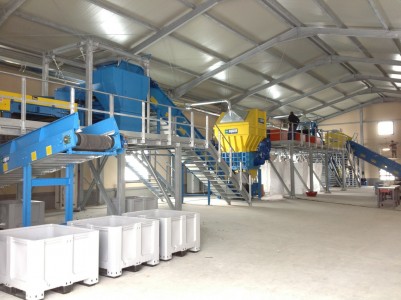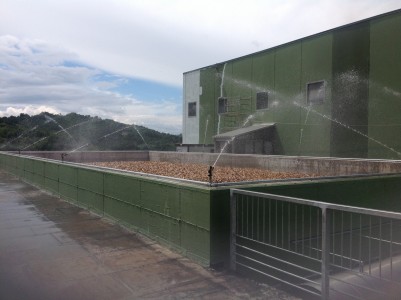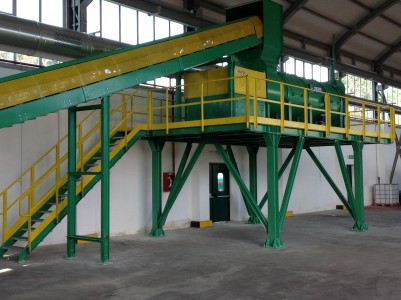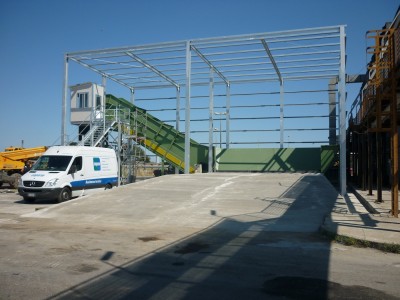waste recycling plants
Coparm designs manufactures and installs waste recycling plants and specific treatments, transport and sorting plants for recyclable materials such as paper, waste collection, multi-material, and industrial waste similar. The success of the treatment of waste fractions is mainly linked to the selection that is made to the origin, greatly improving the recovery rate.
Coparm offers solutions starting from basic systems for manual or mechanical and more complex plants involving specific machinery and equipment more and more ‘sophisticated to get results in full compliance with current regulations regarding waste disposal.
Coparm provides complete and long lasting recycling solutions to turn waste into new, reusable resources with proven technologies. The equipment used for recycling the waste material is manufactured at our sophisticated infrastructure, using premium quality raw material. These are stringently tested on several parameters to ensure the delivery of a flawless range to customers. Furthermore, we also provide customized solutions to clients as per the specifications detailed by them to meet their varied requirements.
Single stream recycling
Single stream, otherwise known as dry commingled waste, comprises mostly of paper & card, plastic packaging waste, textiles and cans. Given that some collection schemes include glass whilst others exclude glass from commingled collection, we have provided figures for both waste types.
The analysis in the table shows the percentage by weight breakdown of the total waste input and then splits this a size further by MRF design and equipment selection. We also show a further breakdown of the paper & card and the dense plastic fraction given the commercial importance of the individual constituents of each fraction as potential pure fractions.
The input stream is analysed by a fast scanning sensor installed over a conveyor belt. It rapidly identifies materials, shapes, textures and colours as well as the object position.
A defined sorting fraction is then propelled onto a second transport system by a gust of air while the residual fraction is transported to a third belt for further sorting or disposal.
Specialist sorting and recovery
At Coparm, our flexible sorting systems function effectively with an extremely wide variety of material streams. They successfully perform an extensive range of sorting tasks and are able to both prepare and sort material for either mechanical recycling or energy recovery.
Together with our customers, we are committed to finding alternatives that will avoid valuable material simply being landfilled or burned. Furthermore, we aim to ensure that the material being further recycled or used in energy recovery will meet the strictest specifications. In doing so, we endeavor to ensure that waste management operators will reduce costs as well as reduce the environmental impact of waste.
Amongst our range of innovative applications, we at Coparm are able to use our systems for a number of different purposes. These include the detection and ejection of silicon cartridges from a PE stream, the detection and ejection of pizza cartons from a cardboard stream and the recovery of recyclables from an industrial waste stream.
Ferrous scrap recycling
Fractions of steel manufactured from ferrous scrap are starting to contain an increasing amount of residual copper. Currently, about 40 % of the worldwide steel production is made from recycled ferrous scrap – and this is increasing all the time.
The biggest challenge in iron recovery is the purity. If the volume of copper content in recycling ferrous scrap is too high, quality in the final product will go down. Only steel scrap that meets the required specifications (e. g. type E40 with less than 0.25 % copper content) may enter the steel production process for high quality products as secondary resource.
Residual copper found in this ferrous scrap is a metallurgical and processing poison, leading to problems when processing scrap metals. When too much copper is found in the steel-making process, the produced steel batch to become brittle or too soft, affecting the overall quality of the steel that is produced.
This rise in the volume of residual copper found in steel-making has been a major concern to everyone from scrap processing plants to steel mills. To fix this problem, recycling facilities are doing everything they can to remove what they see as the main contributor to this increased copper volume, by removing ‘meatballs’ from ferrous scrap.
Copper Meatballs
Copper meatballs are electric motors – usually found in End of Life Vehicles and electrical white goods – which consist of a steel shell, copper wires, and free copper. As they are very often attracted by the magnetic separation in a recycling process, they are often found in ferrous scrap.
These copper meatballs pollute the ferrous scrap, and if they are found in shredded ferrous scrap, the steel content found within the meatballs reduces the market value of the scrap metal.
Copper meatballs, if caught in ferrous scrap sorting, can be responsible for damaging non-ferrous waste separation equipment further on in the separation process, and start fires in waste residue as they retain heat from the shredding process.
Due to the mechanical problems and the lost revenue that copper meatballs can bring, recycling facilities and waste separation plants have been trying to find a new, automated method to remove them from the non-ferrous scrap. At the same time, the automated removal can help to maintain a consistent production of high-quality steel scrap with copper levels at less than 0.20%
Organic waste separation
The Coparm separation systems can be perfectly integrated in your own installation and adapted to specific material types and grain sizes. The process flowchart demonstrates optimized integration of the Coparm separation system.
Following the sieving process, the two fractions of plastic can be recovered. This fraction can be processed to render it resalable, whilst a second stage eliminates the stones, glass and metals before the material enters the biomethanization module.
The total waste volume contains a high percentage of organic material. This fraction is treated in different ways depending on country. Within the organic fraction, the inert material can cause significant problems during the different treatment processes. For this reason, the inert material content has to be reduced to a minimum in such a way that loses as little organic material as possible. For example, in processes producing Bio-gas from the organic fraction, inorganic residue settles at the bottom of the anaerobic digester. In order to run an effective and efficient machine it is necessary to empty and clean the digester more frequently. Time spent cleaning the machine will inevitably mean a loss of time in the Bio-gas production process. Potential mechanical component damage from inorganic residue build up will also lead to additional maintenance costs.
CRT glass sorting
End of life TV sets and computer monitors require to be recycled to maximise the level of material recovery, and to meet the requirements of the EU WEEE Directive.
CRT glass is the largest item by weight. However, because of the 2 different types of glass used in CRT manufacture, the glass fractions have to be sorted to achieve a separation of the 2 type of glass, i.e. panel glass sorted from funnel glass.
Panel glass has virtually no lead content, whilst funnel glass normally has a lead content in the 20-25% range. The lead, in the form of lead oxide, is included as shielding against the X-Rays inherent in TV’s and monitors. It is essential to separate the 2 qualities of glass to maximise the recycling revenues.
Wire recovery
Cable materials were often lost in the treatment and sorting processes available till now, which meant a financial loss due to the high proportion of copper they contain. New sorting technologies such as the Coparm finder are now capable of detecting these cables.
Recover up to 98% of wires from metal scrap!
Copper cables and free copper particles are valuable components which are contained in lots of waste fractions such as:
Heavy fractions from automobile shredders (SSF)
Light fractions from automobile shredders (SLF)
Waste electrical and electronic equipment (WEEE)
Residual materials and metals from dense medium separation systems (DMS)
The safe identification of copper cable in these material flows with conventional sorting technology is not possible. Cable processors and secondary copper smelters demand high purity mono-fractions of copper concentrate and cables. These can only be efficiently gained by using the new sensor-supported sorting systems.
Construction and demolition recycling
Processing C&D requires extremely resilient equipment. Combining heavy-duty conveyors with state-of-the-art automated screening technology, we can custom design the most rugged and effective C&D recycling system for your operation to recover concrete, wood, metals, glass, plastics and other salvaged building components.
Recycling sorting systems
We have engineered, manufactured, and installed material recovery facilities all over the country (MRFs). Not only do our systems provide the highest efficiency in producing marketable end-products, you also will experience minimized labor costs, maximized throughput, and conservation of energy with our intelligent motor control systems.
With experience in providing systems for various tonnages, materials, and customer goals, we assure you that you will be not only satisfied, but impressed with our expertise as we work with you to establish the right layout and design for your material recovery facility.
Recycling sorting equipment
We provide all the equipment for all types of material recovery facilities, from the tipping floor to the bale storage area and everything in between. Our systems are smart systems. Thanks to our intelligent motor control systems, all of our equipment, no matter which manufacturing division of the CP Group engineered and manufactured it, are synergistically integrated. We offer solutions for plastic, cardboard, paper, aluminum, steel, e-Waste and glass separation. Our superior sorting equipment line includes disc screens, trommels, conveyor systems, air classifiers, metering equipment, optical sorters, glass crushers, magnetic separation equipment, and an extensive line of balers to tie it all together.
Recycling Sorting Systems
Recycling Sorting Equipment
Disc Screens
Trommel Screens
Plastic Recycling Equipment
Cardboard Recycling Equipment
Paper Recycling Equipment
Aluminum Recycling Equipment
Steel Recycling Equipment
Glass Recycling Equipment
Recycling Conveyor
Metering Equipment
Bag Opener
Waste Recycling Equipment
Optical Sorting Equipment
Baling Equipment
Aluminum Can Recycling Machines
Optical sorting equipment
Advanced optical sorting systems from MSS are field-proven to give you the most efficient separation of recyclables available, while providing you with the cost-effective, time-saving technology you need to meet current market demands and take your operation into the future. Designed, engineered and manufactured in-house, MSS systems are the high-speed automated answer to your sorting requirements. Regardless of your plant size or specific need, you can depend on more than 30 years of MSS experience to engineer a cutting edge solution that is custom designed to increase your productivity – and profits – automatically.
Baling equipment
Coparm designs and manufactures a complete line of balers with innovative features for superior performance and unmatched production. Coparm produces one of the most extensive lines of balers in the waste and recycling industry. We have top-of-the-line balers for almost any material type.
Coparm puts customer service first- their experienced team works with you to maximize system uptime. Coparm leads the baling industry with continuous innovation and superior design. You can be confident in relying on Coparm’s superior customer service and high-performing heavy-duty balers.
Aluminium can recycling machines
Coparm products are engineered and built in our own plant and field-tested in our own recycling centers and MRF. We’ve manufactured the majority of used beverage container recycling equipment in the world. We know what it takes to get the job done right.
There’s simply no more efficient way to process aluminum cans than to densify them. Each of our innovative densifiers is tried and tested to deliver ultimate reliability, low-maintenance operation and excellent results. All Coparm densifiers are cost-effective and feature:
Fully automatic cycle allowing for maximum pounds-per-hour throughput and eliminating the need for constant attendance.
All machine functions operated by solid state, programmable controller.
Lowest maintenance possible due to minimum number of moving parts.
All moving parts fully enclosed for maximum operational safety.
Systems for the treatment of plastic
(pet, hdpe/ldpe, pp, abs, ps, papa, pvc and much more)
Our shredder and grinders have a wide range of applications in the world of plastic, preparing the materials for the successive recycling and reuse operations.
Thanks to our machinery, bumpers and tanks, containers and cisterns of various sizes, drains, flasks and bottles in PET, film etc. become a valuable end product to be reused like new raw material.
Recycling Sorting Systems
Recycling Sorting Equipment
Optical Sorting Equipment
Baling Equipment
Aluminum Can Recycling Machines
Recycling Equipment
Coparm has been manufacturing recycling equipment for nearly 4 decades, we lead the industry and continuously make improvement and develop new equipment as markets and needs change.
We have a complete line of recycling equipment to ensure the highest recovery rates for virtually any material type. Our recycling equipment is for: single stream recycling, municipal solid waste, waste to energy front-end separation, construction and demolition, commercial and industrial, e-Waste, food waste, and green waste recovery.
Material Recovery Facilities
Intelligent Motor Control Systems
Transfer Station Recycling
Recycling Sorting Equipment
Optical Sorting Equipment
Baling Equipment
Aluminum Can Recycling Machines
Transfer Station Recycling
Transfer stations are waste handling sites for the temporary holding storage of waste being transported from local communities to the landfill. Usually, this is one of the last places waste accumulates before entering a landfill; there is an opportunity to recover recyclables one last time before they are land-filled.
There is a trend occurring that is here to stay- material recovery facilities at transfer stations. Some transfer station owners and operators are taking advantage of this opportunity, leveraging their assets to recover recyclables, which in the long run is a smart investment, provides longer landfill life,and is better for the environment.
Coparm is contributing to this trend by working with transfer stations to set up material recovery systems, whether it is a simple commingled sort line or a more complex automated system. We will analyze your material streams to find the best solution for your opportunity. Our recycling sorting equipment delivers high throughput of clean streams and minimizes maintenance.
Plastic Recycling Equipment
Coparm is the world leader in automated sorting systems. Our plastic sorting modules provide accurate separation of specific plastics from mixed waste streams. Employing near infrared (NIR) sensor technology to analyze and classify polymers, aseptic packaging and paper according to their unique signature allows you to easily process multiple input streams at the highest speeds attainable. All colors & resins (PET, HDPE, PVC, PP, PS, PLA, and more) are accurately and efficiently separated by our top-of-the-line optical sorting solutions:
applications:
Plastic Recycling Equipment
Cardboard Recycling Equipment
Paper Recycling Equipment
Aluminum Recycling Equipment
Steel Recycling Equipment
Glass Recycling Equipment
Recycling Conveyor
Metering Equipment
Bag Opener
Waste Recycling Equipment
Optical Sorting Equipment
Baling Equipment
Aluminum Can Recycling Machines
Cardboard Recycling Equipment
Cutting edge fiber separation technology that delivers the most efficient OCC (old corrugated cardboard) separation in the industry. Our exclusive OCC Disc Screen automatically separates cardboard from other fibers, containers and debris. Innovative and field-proven, this proprietary technology assures you of ultra-efficiency and long range durability, designed and engineered to increase your profit making potential, automatically.
Features & Benefits:
Variable speed drive to allow operator to adapt to material
Lowest maintenance requirements in the industry
Easily integrated into existing system
Available in 2-deck or 3-deck configuration to ensure the highest quality end product
Modular so easy to retrofit into existing system
Welded design for easy maintenance
Easy access to each rotor
Width available in 80’’ or 100’’ options
Lifting eye plates for ease of installation
Multiple clean-out doors for easy maintenance
Shear bars at transition point to guide material flow
Special serrated elliptical discs made of 1/2″ thick steel plate
Capacity up to 30TPH
Two (2) 7.5 HP gear motors
Variable speed drive motors options
Paper Recycling Equipment
Coparm Disc Screens automatically separate newspaper, containers and mixed paper rigid containers from paper by means of patented disc screen technology. Disc patterns can be configured to separate rigid containers from mixed paper easily and efficiently. Or, with a more open configuration, you can separate newspaper from mixed paper–automatically. Combining Coparm’s patented molded rubber finger discs, variable speed drives and hydraulically adjustable deck angle, Coparm’s screens ensure that material is sized properly for the most efficient sort possible.
Aluminum Recycling Equipment
Aluminum is passed over the rotor which contains a rotating series of powerful rare earth magnets causing an eddy current reaction to the aluminum. Our eddy current separator ejects the aluminum with the same force as a magnet pulls steel.
Coparm’s Eddy Current Separator easily separates aluminum cans from other materials in the material stream. As aluminum cans or other non-ferrous metals pass over the drum, the alternating magnetic field creates eddy currents that repel the material away from the conveyor. While other materials drop off at the end of the conveyor, the non-ferrous metals are propelled over a splitter for separation. The Coparm Eddy Current Separator is fastest and most cost effective way to retain valuable aluminum from the recycling or waste stream.
Features & Benefits:
Automatically separates aluminum from other materials
Rare Earth Magnetic Drum
Heavy Duty Frame
Adjustable splitter at material discharge
Shaft mounted, TEFC, belt gear reducer motor
Variable speed conveyor
Low profile for easy integration into existing system
250 – 400 feet per minute
30″ – 36″ – 48″ – 60″ widths available
4 – 13 tons per hour, depending on width
230, 460 volt 3 phase standard – optional voltages available
Steel Recycling Equipment
Coparm offers a heavy duty drum magnet for high volume ferrous separation and recovery. It has a tough and rugged design that performs even under the harshest conditions. This large, powerful magnetic drum has a non-magnetic exterior shell that is driven around a fixed magnet center. Ferrous metals are drawn out of the material stream by the powerful magnetic center and held against the revolving shell; the steel is released when it reaches a discharge point beyond the magnetic field. The magnet placement is customizable and can be fed in any position; the drum can drop the ferrous material off over the drum, under the drum, or down from the drum if fed from the top.
Features & Benefits:
Heavy duty drum for high volume ferrous separation
Width and sizing options
Customizable feed placement
Very low operating costs
Low maintenance and no cooling oil required
Electro Magnetic Separator
Coparm offers an over-belt Electro Magnetic Separator that allows for quick and efficient separation and recovery of your ferrous material. Positioned over the stainless steel section in your conveyor, ferrous material is attracted to the electro-magnet above and adheres to the conveyor belt running at a cross-angle allowing for transfer to silo or storage container. Available in both electro and permanent magnet styles, these powerful, self-cleaning separators come equipped with a tough, vulcanized rubber belt with cleats to continuously remove steel from the stream. The magnet may be suspended either cross-belt (perpendicular to the product flow) or inline (parallel) above the product flow.
Features & Benefits:
Continuously removes ferrous materials
Self-cleaning belt reduces maintenance
Can be positioned either cross-belt or in-line
10 gauge mild steel plate with stainless steel side plates
Self-Cleaning
2 HP TEFC drive motor
2.5″ rubber cleats
Glass Recycling Equipment
The multi-deck Coparm Glass Breaker Screen simplifies glass processing in any material recovery facility. Cast chromium elliptical discs clocked at 90 degrees break and separate glass at a highly efficient rate. Heavy-duty and low-maintenance, this multi-level screen is field-proven to break and separate broken glass and fines from newspaper and whole containers at optimum efficiency; sizes glass without pulverizing.
Features & Benefits:
Maximizes glass breakage and capture rates
Minimizes wear and tear on downstream equipment
Increases system throughput and uptime
Lowest maintenance costs in the industry
Fast retrofit
Dramatically improves marketability of end products
Heat treated, abrasion resistant
Heavy duty structural steel frame
Automatic lubrication option available
Coparm Glass Breaker
The Coparm Glass Cleaner features a unique vacuum system that separates fiber and other light debris from your glass with field-proven results, bringing you to new levels of efficiency and profitability for your operation. Whatever the size of your MRF, you will see an immediate return on your investment – in terms of lower residue and higher end-product marketability.
Features & Benefits:
Provides better separation of light materials from glass
Lowest maintenance costs in the industry
Designed and engineered for fast easy retrofit
Processes up to 5 tons per hour of broken glass
Eliminates light contaminates
Maximizes the quality of your end product
Utilizes a fully adjustable vacuum system for accurate and efficient separation
Variable speed drive to accommodate your processing needs
Urethane wear liners on all wear components increases durability and extends equipment life
Applications and machines:
Recycling Sorting Systems
Recycling Sorting Equipment
Disc Screens
Trommel Screens
Plastic Recycling Equipment
Cardboard Recycling Equipment
Paper Recycling Equipment
Aluminum Recycling Equipment
Steel Recycling Equipment
Glass Recycling Equipment
Recycling Conveyor
Metering Equipment
Bag Opener
Waste Recycling Equipment
Optical Sorting Equipment
Baling Equipment
Aluminum Can Recycling Machines
Waste Plants
Refrigerators plant
Weee plant
Tyres plants
Special Plants
Electrical wire shredding plant
Installation for washing machine recycling
Installation for plastic recycling
Installation for aluminum profiles recycling
Installation for toner recycling
Installation for glass recycling
Installation for Urban solid waste recycling
Installation for the treatment of Industrial waste
Installation for the treatment of aluminum shavings
Recycling Applications
Recycling of plastic
Wood grinding
Paper shredding
Scrap metal shredders
Recycling oil filters
Electrical wire shredding
Processing and recycling refrigerators
Weee processing and recycling
Processing and recycling tyres
